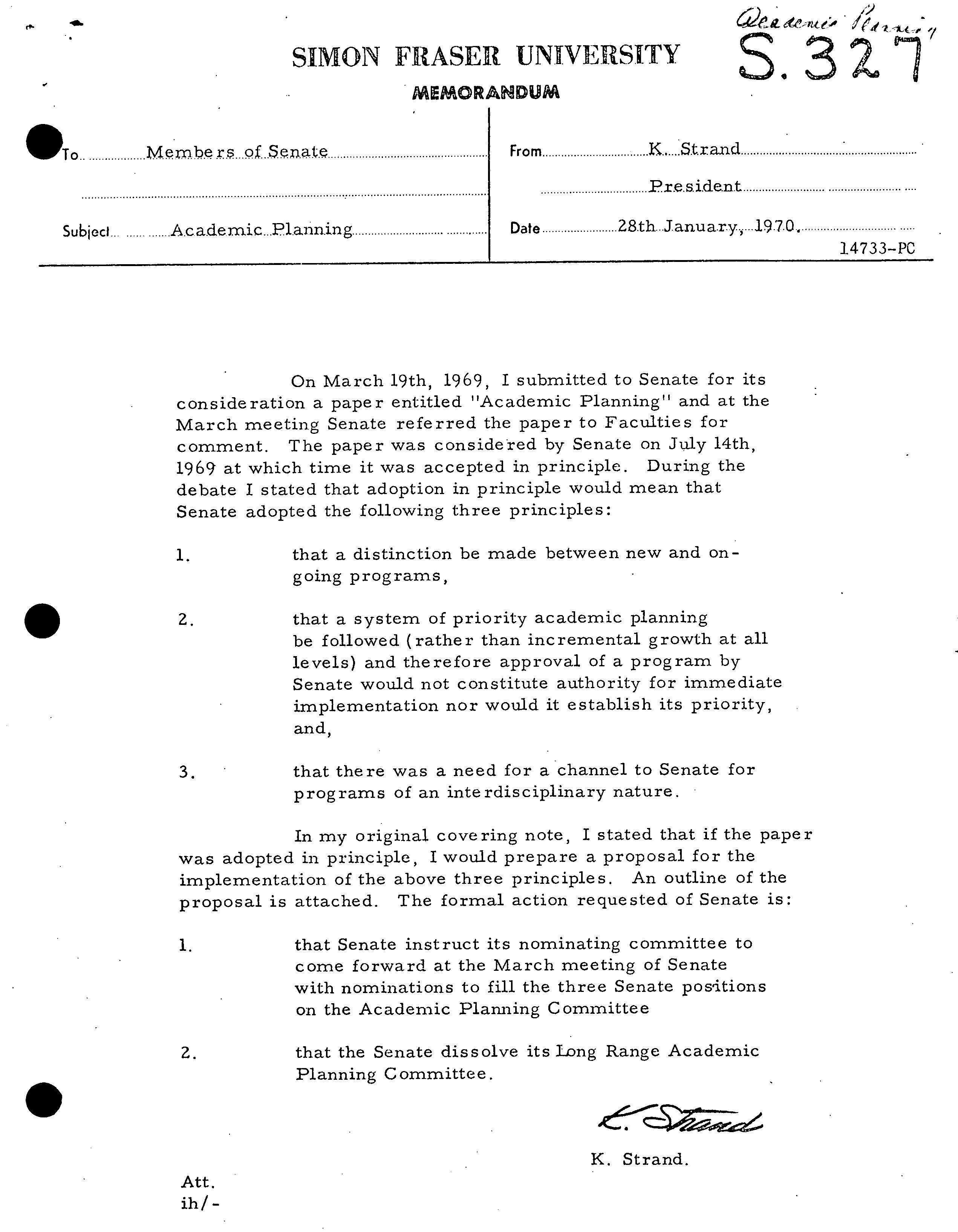Went
,
ete^nte:,
19
. '
SIMON FRASER UNIVERSITY
S. 3
Z
1 /
MEMORANDUM
OT
..S
e,. ?
........................................ .
?
From .................................. K ......
Strand ........................................................
...........................................................................................................President....................................................
Subjeci... ...... .......
Academic ... Planning ...................... ... .... .............
.
Date........................
?
28.th...J.anua.r.y....19.7.0....................................
.
-- --
?
14733-PC
On March 19th, 1969, I submitted to Senate for its
consideration a paper entitled "Academic Planning" and at the
March meeting Senate referred the paper to Faculties for
comment. The paper was considered by Senate on July 14th,
1969 at which time it was accepted in principle. During the
debate I stated that adoption in principle would mean that
Senate adopted the following three principles:
that a distinction be made between new and on-
going programs,
Z. ?
that a system of priority academic planning
be followed (rather than incremental growth at all
levels) and therefore approval of a program by
Senate would not constitute authority for immediate
implementation nor would it establish its priority,
and,
3 ?
that there was a need for a channel to Senate for
programs of an interdisciplinary nature.
In my original covering note, I stated that if the paper
was adopted in principle, I would prepare a proposal for the
implementation of the above three principles. An outline of the
proposal is attached. The formal action requested of Senate is:
that Senate instruct its nominating committee to
come forward at the March meeting of Senate
with nominations to fill the three Senate positions
on the Academic Planning Committee
2. ?
that the Senate dissolve its Long Range Academic
Planning Committee.
. ?
.
?
.
?
.
K. Strand.
Att.
ih
/ -
ACADEMIC PLANNING
Outline: The basic idea is that all new programs go to the
Academic Planning Committee for review prior to submission
to Senate, and if passed by Senate return to the Academic
Planning Committee for assignment of academic priority.
The Academic Planning Committee is an Advisory Committee
to the President. Its formal terms of reference and membership
are presented in Appendix I. Its first responsibility is to
review new programs and to advise the President in his role
as Chairman of Senate.
The second responsibility of the Academic Planning
Committee is to consider annually all new programs approved
by Senate and to recommend to the President both academic
priorities and implementation priorities. This provides the
system of priority academic planning approved by Senate in
July, 1969.
The membership of the Academic Planning Committee
would be the same for both responsibilities; however, the
Deans would not have a vote with regard to the first responsibility,
• ?
1.
e. recommendations on individual proposals that are under
review.
New Programs: It is recognized that a distinction between a new
program and a change in an existing program is not always clear.
Yet, a 'combination of several criteria such as number and
content of courses, requirements of faculty, space and finances
can provide a reliable guide to identification of a new program.
Therefore, for planning purposes, a new prègram is defined as
any proposal involving a restructuring of existing courses or the
introduction of new courses which would result in a major shift in
emphasis of the existing program, which would result in a new
degree being granted by Senate, or which would require additional
staff, funds or space. All proposals falling within this definition
would require review by the Academic Planning Committee. Other
proposals would go directly to Senate without review by the
Academic Planning Committee. However, if in the submission to
Senate no present or anticipated financial commitments are
identified, approval by Senate will not constitute a commitment
to subsequently fund a program. This provides the distinction
between new and on-going programs that was approved by Senate
in
July, 1969.
S ? '
- 2 -
?
e
/M4
?
* p .
.*
Channels to Senate: Proposals will originate from faculty members.
These faculty members may be within a Department (Departmental
S ?
proposals), within two or more Departments within the same
faculty (Intra-Faculty proposals), or within two or more Departments
in more than one faculty (Inter-Faculty proposals). No matter
where they originate all new programs must be reviewed by the
Academic Planning Committee prior to submission to Senate.
By allowing Inter-Faculty proposals to be submitted directly
to the Academic Planning Committee, the channel for inter-
disciplinary proposals that was approved by Senate in July 1969
is established. A schematic diagram of the proposed planning
process is attached as Chart I.
.0
January 28, 1970
I;.
-C4
Air
It4! .
.
?
APPENDIX I
ACADEMIC PLANNING COMMITTEE
Member ship
Academic Vice-President ?
Chairman
Dean of Arts
Dean of Science
Dean of Education
Dean of Graduate Studies (when appointed)
Three Senators (a fourth to be elected concomitant
with the appointment of a Dean of Graduate Studies)
Academic Planner (non-voting)
Terms of Reference
1. To review and recommend to the President, as
Chairman of Senate, all new program proposals
submitted to it.
.
?
2. To develop annually a recommendation to the
President concerning academic and action priority
listings.
3. To undertake such other duties as are assigned
to it by the President.
Further Conditions
The full committee will review all proposals which
come before it. However, the Deans will be non-voting as
regards the recommendation on..individual program proposals
that are under review within the first of the terms of reference.
0
E1
E=
z
-J
z
LU
zo
Wa
CL
I-
I-
JC/)
CL
C/)
U-
•0
>-
F-
-J ?
<C ?
CL
LU
QO
C
z
<LU
CL
LU
0
0
RM
-I
C')
0
CL
CL
-
C)
C)
o
LU
V)Q
-4
CL
Cl) ?
0
Z
¶J/
CD
>
?
C)
o
?
.•-
-
1 ?
C)
0.0
0.
0
?
C)
C)
(Y
CD
C-)
w-J)-.
U
.
Z
z
W ?
—
v)w
o=o
cc
.
0
